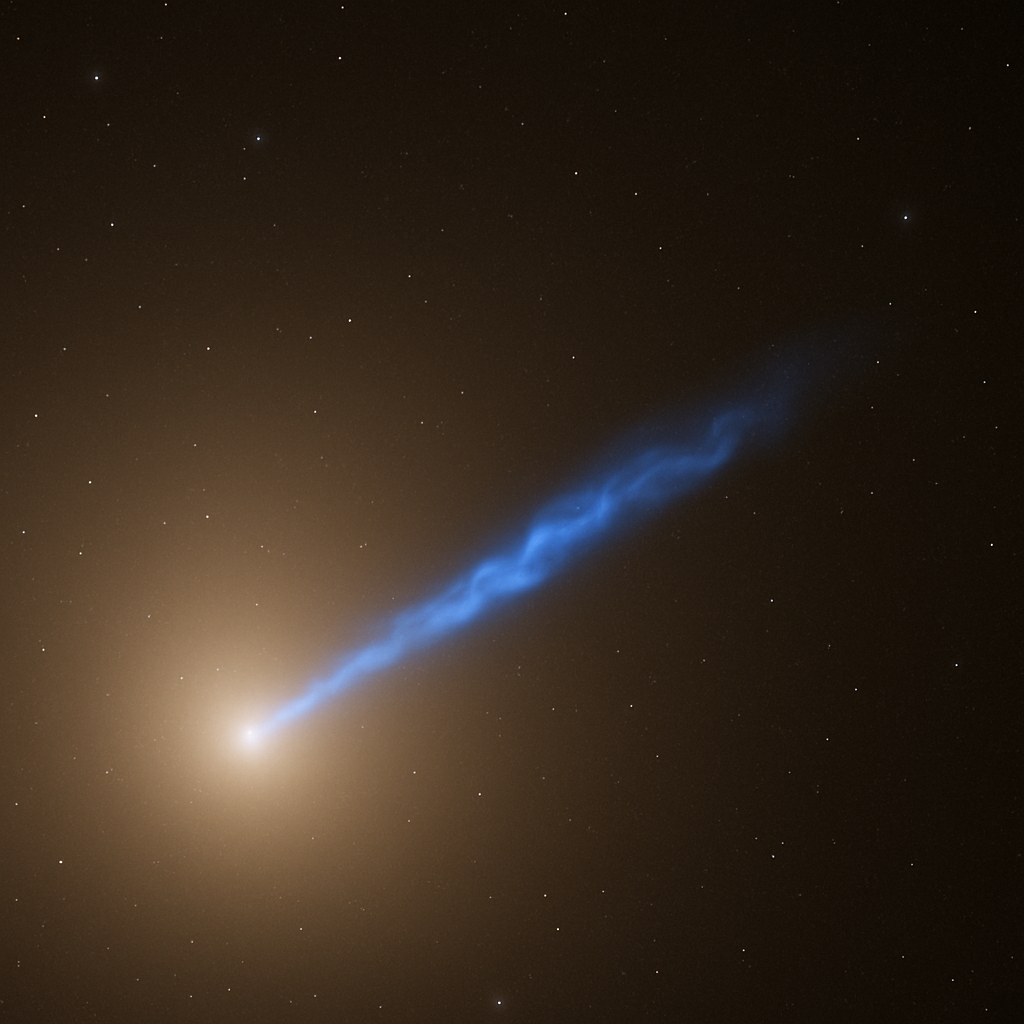⏲️ Estimated reading time: 6 min
Yes, the image is real: it shows the relativistic jet of galaxy M87, captured by Hubble. However, some claims in the viral text are exaggerated jets don’t “make stars explode,” and Earth is in no danger from this phenomenon.
Galaxy M87
Social media often spreads stunning space images paired with dramatic, sometimes misleading descriptions. One viral post shows a glowing blue jet emerging from a galaxy’s core, claiming it’s a “small jet of plasma” 3,000 light-years long, observed by Hubble for nine months, during which “nearby stars exploded.” It warns that if such a jet reached Earth, our atmosphere would vanish, oceans would evaporate, and the planet would become a dead rock though, supposedly, we’re “lucky it can’t get here.”
In this article, we’ll fact-check those claims, explain what the image really shows, put the scale in context, and clarify the actual risks. In short: the image is authentic, but several of the statements are misleading or exaggerated.
What the Image Actually Shows
The photograph captures the relativistic jet of the giant elliptical galaxy M87 (Messier 87), located in the Virgo constellation about 53–55 million light-years away. At its core lies a supermassive black hole the same one famously imaged by the Event Horizon Telescope in 2019. As matter spirals inward, magnetic fields funnel some of it outward at near-light speed, forming a narrow jet of plasma that stretches thousands of light-years.
In visible light, the brightest portion of the M87 jet extends several thousand light-years (Hubble highlights ~5,000 ly). In radio waves, the lobes powered by the same process can span hundreds of thousands of light-years. So yes: tiny compared to the universe, but colossal compared to our solar system.
Comparing the Jet to Our Solar System
Let’s break it down with two key measurements:
- Neptune’s orbit diameter: ~60 AU, or ~0.001 light-years.
- Heliosphere (the solar wind bubble): ~100–120 AU, ~0.002 light-years.
If M87’s optical jet is ~3,000–5,000 light-years long, you could fit 1.5–5 million “solar systems” into it. So the viral claim that “our system would be invisible, one tiny segment out of millions” is correct in order of magnitude.
Did Hubble Watch Stars Explode Near the Jet?
No.
Hubble has indeed tracked M87’s jet over many years, observing bright “knots” of plasma moving at apparent superluminal speeds (a relativity effect). But there is no record of stars “exploding nearby” because of the jet.
Jets can:
- Heat and compress surrounding gas.
- Trigger or suppress star formation in gas clouds.
- Emit across the spectrum (radio, optical, X-ray) through synchrotron radiation.
But they do not directly detonate stars. That claim is misleading.
Would a Jet Destroy Earth’s Atmosphere and Oceans?
Not from M87, and not like that.
It’s true that extremely powerful, directed radiation like a gamma-ray burst from a nearby star could strip away ozone and devastate life. But the M87 jet:
- Isn’t pointed at us.
- Is tens of millions of light-years away.
- Loses intensity with the square of distance.
By the time its radiation reaches Earth, it’s faint. No threat of “instant evaporation of oceans” exists here.
Why the Jet Appears Blue
The “blue glow” in Hubble’s image isn’t literal color. It’s a false-color mapping of synchrotron radiation from electrons accelerated in magnetic fields. Astronomers choose colors for contrast and scientific clarity, not to mimic what human eyes would see. In reality, much of this light is outside the visible range.
How Fast Does the Jet Move?
Particles in the jet travel at relativistic speeds (close to light). When knots move almost along our line of sight, perspective makes them look like they move faster than light an optical illusion called apparent superluminal motion. Physics isn’t broken; relativity explains it.
Farther out, the jet slows, broadens, and dims as it collides with surrounding gas.

Jet Physics in a Nutshell
- Accretion: Gas falls into the black hole, forming a hot accretion disk.
- Magnetic fields: Twisted magnetic lines channel plasma outward.
- Launch: Energy from the black hole’s spin powers twin jets.
- Emission: Electrons produce synchrotron radiation, visible across the spectrum.
Many galaxies quasars, radio galaxies, active galactic nuclei show similar jets. M87 is simply nearby and bright enough to study in detail.
Why M87 Is So Famous
- Relatively close for an active galaxy: ~55 million light-years.
- Hosts a giant black hole (billions of solar masses).
- Visible jet in optical light, perfect for Hubble’s long-term tracking.
- Linked to the first-ever black hole image in 2019.
It’s a cosmic “laboratory” for jet physics.
Why Earth Is Safe
- Distance: 50+ million light-years.
- Orientation: jet points sideways, not at us.
- Intensity: fades drastically with distance.
- Planetary shields: Earth’s atmosphere and magnetic field block most radiation anyway.
So while the jet is awe-inspiring, it’s harmless to us.
How Viral Misinformation Spreads
- Mix of fact and hype: real numbers combined with exaggerated doom.
- Missing context: distance and orientation left out.
- Alarmist tone: “oceans evaporated,” “Earth turned to stone.”
- Color confusion: science maps mistaken for literal flames.
It’s compelling but misleading.
Lessons on Scale
Yes, our solar system is a speck compared to a 5,000 light-year jet. But that doesn’t mean danger. It means perspective: cosmic structures dwarf us, yet they’re far away and scientifically fascinating, not threats to daily life.
FAQs
1) Is the image real?
Yes. Hubble and ground telescopes have imaged M87’s jet repeatedly.
2) Is it 3,000 light-years long?
In visible light, yes thousands of light-years. In radio, hundreds of thousands.
3) Do jets make stars explode?
No. They affect gas clouds but don’t detonate stars.
4) Is Earth at risk?
No. Too far, not aligned with us.
5) Why is it blue?
False-color representation of synchrotron emission.
Conclusion
The viral image is real and extraordinary: Hubble captured the relativistic jet of M87’s supermassive black hole. The claims that it makes stars explode and could instantly sterilize Earth are exaggerated or false. This phenomenon is a reminder of the universe’s immense scales not of imminent danger.
Enjoy the wonder of cosmic jets for what they are: spectacular physics on a grand scale, safely out of reach.
🔔 For more tutorials like this, consider subscribing to our blog.
📩 Do you have questions or suggestions? Leave a comment or contact us!
🏷️ Tags: M87, relativistic jet, Hubble, supermassive black hole, active galaxy, synchrotron radiation, science fact-check, astronomy explained, plasma physics, astrophysics
📢 Hashtags: #M87, #Hubble, #BlackHole, #RelativisticJet, #Astronomy, #Astrophysics, #SpaceExplained, #Cosmos, #ScienceFacts, #Debunking
Only logged-in users can submit reports.
Discover more from HelpZone
Subscribe to get the latest posts sent to your email.

